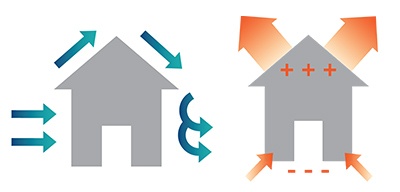No matter what you call it, air flow and its management are vital to the performance, energy efficiency and comfort of a new or renovated home. Not only that: improper air flow can have severe effects on the health and safety of the people in the building by promoting mold growth, spreading pollutants, and possibly creating backdrafting of combustion appliances, increasing the possibility of carbon dioxide poisoning.
Clearly managing air flow is an important and complicated subject.
About Air Pressure
Air flow always seeks the path of least resistance, automatically moving from a high-pressure area to a low-pressure one. Generally speaking, for every volume of air that enters a house, an equal volume of air must also exit the building and vice versa. Pressure differences across holes, boundaries, and barriers within a building are caused by one of three forces: wind, heat or fans.
The Effects of Fans
Fans – particularly exhaust fans and HVAC handlers – can have a drastic effect on air pressure in the home. Exhaust fans can compete with combustion devices like boilers and fireplaces for the air inside the building. This can cause backdrafting and the possibility of carbon dioxide poisoning. HVAC fans can exacerbate the effects of leaky ducts, causing infiltration rates to increase by as much as 300 percent, increasing heating and cooling energy use and decreasing heating and cooling equipment efficiency.
Air Flow Imbalance
An imbalance of air flow across interior or exterior walls, ceilings, and floors can also cause pressure differences. Imbalanced air flow can occur if the supply and return air flows in an area are not equal or if closed interior doors block the supply and return paths, hurting the overall indoor air quality. This can cause backdrafting. It can also drive warm, moist air into the walls and ceilings of closed rooms, possibly leading to mold growth and rot.

Effects of Air Flow on Energy Efficiency
Unwanted air flow can reduce the energy efficiency of a building, even if the building is tightly sealed to the outside. How? One way is through high infiltration rates from natural (wind and stack) and mechanical air movement (HVAC fans). Convection currents inside building spaces are another way air flow can reduce energy efficiency, even though it does not increase infiltration or air-change rates. Finally, any conditioned air that is able to pass through or around insulation into an unconditioned area lowers a building’s energy efficiency.
Air flow in a building has many causes and can take many names, not all of them positive for your clients. Managing the many forms of air flow is critical. Along with moisture and heat management, it’s part of a whole-house systems approach that can create better homes for today’s homeowners.
Want more specifics about managing moisture, heat and air flow in homes? Download our Building Science 101 guide now for more information and suggested solutions.





